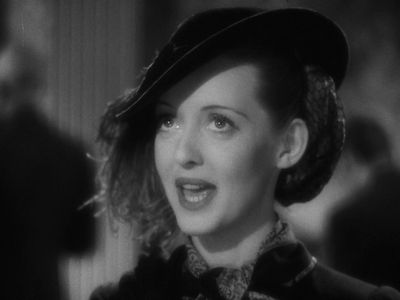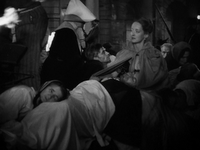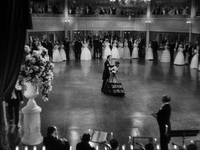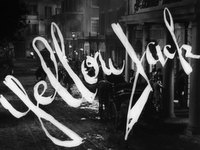 Miss Julie (Bette Davis) is a spoiled young lady who gets entirely too much satisfaction crushing every single taboo she can get her hands on. Not only does she arrive late to a party held in her honor, but then she rides her pony directly up to the hall and enters the ballroom in her riding clothes. Later she attends another ball in a devilish red dress instead of the customary white dress (thus offending 99% of the crowd, particularly the other women). She breaks the “men’s only” rule and enters a bank un-chaperoned. Just about everything that Miss Julie does flies in the face of genteel Southern customs – as if she stepped directly out of a Virginia Slims ad into the antebellum aristocracy.
Miss Julie (Bette Davis) is a spoiled young lady who gets entirely too much satisfaction crushing every single taboo she can get her hands on. Not only does she arrive late to a party held in her honor, but then she rides her pony directly up to the hall and enters the ballroom in her riding clothes. Later she attends another ball in a devilish red dress instead of the customary white dress (thus offending 99% of the crowd, particularly the other women). She breaks the “men’s only” rule and enters a bank un-chaperoned. Just about everything that Miss Julie does flies in the face of genteel Southern customs – as if she stepped directly out of a Virginia Slims ad into the antebellum aristocracy.  This gal is a hellcat. A few more Julies strategically placed would have destroyed the land of Dixie before the Yanks would've ever been needed. As with Scarlett in Gone with the Wind, Julie must have her way all the time. Her central focus in the picture is her ex-fiancé, Preston (Henry Fonda). Unfortunately he went away on account of her sass and came back a year later married to a yankee. That is no concern for Julie, though, because she continues her scheming and plotting to get him back. When Preston is caught on the wrong side of the fever line with the contagious Yellow Jack (Yellow Fever, that is), Julie bravely sneaks down to New Orleans from her safe haven near Baton Rouge so that she may nurse Preston in his hour of need. His yankee wife shows up a little later. When it comes time for Preston to be shipped off to Lazarette Island (where the Yellow Fever victims are banished), Julie convinces Preston’s wife that she [Julie] should go with him instead of his wife. Despite the fact that this action means almost certain death for Julie, it is unclear whether her daring decision is the result of her maturation or whether it is another childish scheme to win Preston back, even in death.
This gal is a hellcat. A few more Julies strategically placed would have destroyed the land of Dixie before the Yanks would've ever been needed. As with Scarlett in Gone with the Wind, Julie must have her way all the time. Her central focus in the picture is her ex-fiancé, Preston (Henry Fonda). Unfortunately he went away on account of her sass and came back a year later married to a yankee. That is no concern for Julie, though, because she continues her scheming and plotting to get him back. When Preston is caught on the wrong side of the fever line with the contagious Yellow Jack (Yellow Fever, that is), Julie bravely sneaks down to New Orleans from her safe haven near Baton Rouge so that she may nurse Preston in his hour of need. His yankee wife shows up a little later. When it comes time for Preston to be shipped off to Lazarette Island (where the Yellow Fever victims are banished), Julie convinces Preston’s wife that she [Julie] should go with him instead of his wife. Despite the fact that this action means almost certain death for Julie, it is unclear whether her daring decision is the result of her maturation or whether it is another childish scheme to win Preston back, even in death. The movie ends with Julie attending to Preston on the way to Lazarette Island, but it does not show the two on the island. That’s a curious omission since the entire film seems to lead Julie to encounter death, face to face. Had the film showed Julie facing the horrors of the island, then the audience could have determined whether or not Julie's character grew over the course of the story. This miscalculation in Jezebel is no fault of Betty Davis whose portrayal is inspired and magnificent. Whereas Vivian Leigh’s Scarlett is more unassuming in her audacity, Davis’s Julie is more exacting (even when her thinking is wrong).
The movie ends with Julie attending to Preston on the way to Lazarette Island, but it does not show the two on the island. That’s a curious omission since the entire film seems to lead Julie to encounter death, face to face. Had the film showed Julie facing the horrors of the island, then the audience could have determined whether or not Julie's character grew over the course of the story. This miscalculation in Jezebel is no fault of Betty Davis whose portrayal is inspired and magnificent. Whereas Vivian Leigh’s Scarlett is more unassuming in her audacity, Davis’s Julie is more exacting (even when her thinking is wrong).Henry Fonda’s portrayal of Preston is not so wishy-washy as his counterpart in Gone with the Wind, Ashley Wilkes. At the beginning of Jezebel, when Preston is still engaged to Julie, he seems content on giving her a long leash. Despite her father’s encouragement for Preston to beat Julie into submission, Preston refrains. When Julie insists on wearing a devilishly red dress to the ball, however, Preston is pushed beyond his limits. In a brilliant courtship maneuver, Preston accompanies the red-clad Julie to the ball and then forces her to dance all night long. Julie breaks down at the immense consternation she receives on the dance floor and begs Preston to take her back home, but he refuses and continues to force her to dance (the rest of the dancers have long since cleared the floor). Preston manages her with a sure hand, quietly rubbing her nose in her own audacity as if it was a wet spot on the floor. Yet, mysteriously, Preston does not use this demonstration of his
 power as a tool for their future relationship. When he finally returns her home after the ball, Preston says goodbye. Off screen, Preston goes up north and comes back years later with a Yankee wife, proof that he is over Julie for good. There are moments when Julie’s efforts come close to jeopardizing his fidelity, but unlike Ashley Wilkes, Preston stands firm. It is love’s tragedy that someone as vivacious as Julie (with such an exquisite bossom) pined away all her time hoping to regain Preston’s hand in vain.
power as a tool for their future relationship. When he finally returns her home after the ball, Preston says goodbye. Off screen, Preston goes up north and comes back years later with a Yankee wife, proof that he is over Julie for good. There are moments when Julie’s efforts come close to jeopardizing his fidelity, but unlike Ashley Wilkes, Preston stands firm. It is love’s tragedy that someone as vivacious as Julie (with such an exquisite bossom) pined away all her time hoping to regain Preston’s hand in vain. Jezebel has much to augment the character aspects of the story. Through the capable hands of the Warner Brothers set designers, New Orleans is brought to life with all its historic (and romantic) possibilities. Street scenes and barroom scenes are masterfully done. According to the movie, duels were still a common practice and speaking a woman’s name in a bar was grounds for a duel. There is a lot of discussion about the Yellow Fever and several old men talk about the horrible epidemic in 1836. Dialogue describing things off screen is very important for creating the world on the screen, and this movie does a wonderful job at it. Though the Yellow Fever is not seen, talk of draining the swamps and taking all the smart precautions to save New Orleans reinforces the sense that off camera there is a whole city. When the Yellow Fever approaches and the main characters retreat to the plantation north of the fever line, a sense of isolation steals over the audience.
Jezebel has much to augment the character aspects of the story. Through the capable hands of the Warner Brothers set designers, New Orleans is brought to life with all its historic (and romantic) possibilities. Street scenes and barroom scenes are masterfully done. According to the movie, duels were still a common practice and speaking a woman’s name in a bar was grounds for a duel. There is a lot of discussion about the Yellow Fever and several old men talk about the horrible epidemic in 1836. Dialogue describing things off screen is very important for creating the world on the screen, and this movie does a wonderful job at it. Though the Yellow Fever is not seen, talk of draining the swamps and taking all the smart precautions to save New Orleans reinforces the sense that off camera there is a whole city. When the Yellow Fever approaches and the main characters retreat to the plantation north of the fever line, a sense of isolation steals over the audience.  Towards the end, the fever reveals itself. First, a runaway line-breaker is shot by some patrols near the plantation; then Preston is bit by a misquito; and finally Preston has to go to New Orleans to help the fever victims. The fever gradually gets closer to the events in the movie. When Julie arrives in New Orleans to care for Preston, the streets are lined with fires to ward off the insects, people are huddled in rooms trying to avoid the pandemic and everybody is near panic. But that is as close as the audience gets to the fever. Though much was said about Lazarette Island and it was naturally assumed that the story would go there, it cuts off, instead, on the way to the island. The pay-off scenes, with horrific images likened to a Gustav Dore print, never happen. Perhaps budget restraints interfered with the final production, but such a scene could have given this film an extra one and a half stars. As it stands, there is no resolution, no dramatic release and, subsequently, no four stars.
Towards the end, the fever reveals itself. First, a runaway line-breaker is shot by some patrols near the plantation; then Preston is bit by a misquito; and finally Preston has to go to New Orleans to help the fever victims. The fever gradually gets closer to the events in the movie. When Julie arrives in New Orleans to care for Preston, the streets are lined with fires to ward off the insects, people are huddled in rooms trying to avoid the pandemic and everybody is near panic. But that is as close as the audience gets to the fever. Though much was said about Lazarette Island and it was naturally assumed that the story would go there, it cuts off, instead, on the way to the island. The pay-off scenes, with horrific images likened to a Gustav Dore print, never happen. Perhaps budget restraints interfered with the final production, but such a scene could have given this film an extra one and a half stars. As it stands, there is no resolution, no dramatic release and, subsequently, no four stars. 








.jpg)






2 comments:
I love your description.
Your wanting an ending showing every if, and, and but of what happened on Lazarette Island is indicative of the world we live in, in which everyone wants everything handed to them. Where's your imagination? The ending is left deliberately ambiguous, so that each viewer can read what they want into it. As far as budgetary restrictions go, this was one of the highest budgeted Warner Brothers movies to date, and money had nothing to do with the way the film ends.
By the way, it's "Bette," not "Betty," and "Vivien," not "Vivian".
Post a Comment